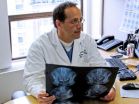(Press-News.org) Blue light can selectively eradicate Pseudomonas aeruginosa infections of the skin and soft tissues, while preserving the outermost layer of skin, according to a proof-of-principle study led by Michael R. Hamblin of the Massachusetts General Hospital, and the Harvard Medical School, Boston. The research is published online ahead of print in the journal Antimicrobial Agents and Chemotherapy
"Blue light is a potential non-toxic, non-antibiotic approach for treating skin and soft tissue infections, especially those caused by antibiotic resistant pathogens," says Hamblin.
In the study, animal models were infected with P. aeruginosa. All of the animals in the group treated with blue light survived, while in the control, 82 percent (9 out of 11) of the animals died.
Skin and soft tissue infections are the second most common bacterial infections encountered in clinical practice, and represent the most common infection presentation—more than 3 percent—in patients visiting emergency departments, says Hamblin. The prevalence of skin and soft tissue infections among hospitalized patients is 10 percent, with approximately 14.2 million ambulatory care visits every year and an annual associated medical cost of almost $24 billion (equivalent to $76 for every American), says Hamblin.
Treatment of skin and soft tissue infections has been significantly complicated by the explosion of antibiotic resistance, which may bring an end to what medical scientists refer to as the antibiotic era, says Hamblin. "Microbes replicate very rapidly, and a mutation that helps a microbe survive in the presence of an antibiotic drug will quickly predominate throughout the microbial population. Recently, a dangerous new enzyme, NDM-1, that makes some bacteria resistant to almost all antibiotics available has been found in the United States. Many physicians are concerned that several infections soon may be untreatable."
Besides harming public health, antibiotic resistance boosts health care costs. "Treating resistant skin and soft tissue infections often requires the use of more expensive, or more toxic drugs, and can result in longer hospital stays for infected patients," says Hamblin.
###
A copy of the manuscript can be found online at http://bit.ly/asmtip0113b. Formal publication of the paper is scheduled for the March 2013 issue of Antimicrobial Agents and Chemotherapy.
(T. Dai, A. Gupta, Y.-Y. Huang, R. Yin, C.K. Murray, M.S. Vrahas, M. Sherwood, G.P. Tegos, and M.R. Hamblin, 2013. Blue light rescues mice from potentially fatal Pseudomonas aeruginosa burn infection: efficacy, safety, and mechanism of action. Antim. Agents Chemother. Published ahead of print 21 December 2012 ,doi:10.1128/AAC.01652-12)
Antimicrobial Agents and Chemotherapy is a publication of the American Society for Microbiology (ASM). The ASM is the largest single life science society, composed of over 39,000 scientists and health professionals. Its mission is to advance the microbiological sciences as a vehicle for understanding life processes and to apply and communicate this knowledge for the improvement of health and environmental and economic well-being worldwide.
Skin, soft tissue infections succumb to blue light
2013-01-29
ELSE PRESS RELEASES FROM THIS DATE:
Injecting botox into stomach does not promote weight loss
2013-01-29
Bethesda, MD (Jan. 28, 2013) – Despite conflicting data in support of the practice, some overweight Americans looking for an easy fix have turned to gastric botox injections to help them lose weight. This month in Clinical Gastroenterology and Hepatology, the official clinical practice journal of the American Gastroenterological Association, researchers from the Mayo Clinic publish a definitive study finding that Botox doesn't promote weight loss.
Injecting botulinum toxin A (BTA), or Botox, into the stomach had been believed to delay emptying of the stomach, increase ...
New study shows stable fisher population in the Southern Sierra Nevada
2013-01-29
ARCATA, Calif.—After experiencing years of population decline on the West Coast, a recent study examining fisher populations found that—at least in the southern Sierra Nevada—the animal's numbers appear to be stable.
Scientists from the U.S. Forest Service's Pacific Southwest Research Station (PSW) and the Pacific Southwest Region collaborated to monitor the distribution of fishers across a 7,606-square-mile area in the southern Sierra Nevada. They used baited track-plate stations—an enclosure where the fisher leaves a sooted track print as it walks through—at 223 locations ...
Using Twitter to track the flu: A better way to screen the Tweets
2013-01-29
Sifting through social media messages has become a popular way to track when and where flu cases occur, but a key hurdle hampers the process: how to identify flu-infection tweets. Some tweets are posted by people who have been sick with the virus, while others come from folks who are merely talking about the illness. If you are tracking actual flu cases, such conversations about the flu in general can skew the results.
To address this problem, Johns Hopkins computer scientists and researchers in the university's School of Medicine have developed a new tweet-screening ...
Climate change projected to alter Indiana bat maternity range
2013-01-29
Research by US Forest Service scientists forecasts profound changes over the next 50 years in the summer range of the endangered Indiana bat. In an article published in the journal Ecology and Evolution, Forest Service Southern Research Station researchers Susan Loeb and Eric Winters discuss the findings of one of the first studies designed to forecast the responses of a temperate zone bat species to climate change.
The researchers modeled the current maternity distribution of Indiana bats and then modeled future distributions based on four different climate change scenarios. ...
New look at cell membrane reveals surprising organization
2013-01-29
LIVERMORE, CALIF. — A new way of looking at a cell's surface reveals the distribution of small molecules in the cell membrane, changing the understanding of its organization.
A novel imaging study by researchers from Lawrence Livermore National Laboratory, the University of Illinois and the National Institutes of Health revealed some unexpected relationships among molecules within cell membranes.
Their findings provide a new way of studying cell structure and ultimately its function.
Led by Mary Kraft of the University of Illinois, Peter Weber of Lawrence Livermore ...
Eating bright-colored fruits and vegetables may prevent or delay ALS
2013-01-29
New research suggests that increased consumption of foods containing colorful carotenoids, particularly beta-carotene and lutein, may prevent or delay the onset of amyotrophic lateral sclerosis (ALS). The study, published by Wiley in Annals of Neurology, a journal of the American Neurological Association and Child Neurology Society, found that diets high in lycopene, beta-cryptoxanthin, and vitamin C did not reduce ALS risk.
Carotenoids give fruits and vegetables their bright orange, red, or yellow colors, and are a source of dietary vitamin A. Prior studies report that ...
Scientists trick iron-eating bacteria into breathing electrons instead
2013-01-29
Scientists have developed a way to grow iron-oxidizing bacteria using electricity instead of iron, an advance that will allow them to better study the organisms and could one day be used to turn electricity into fuel. The study will be published on January 29 in mBio®, the online open-access journal of the American Society for Microbiology.
The method, called electrochemical cultivation, supplies these bacteria with a steady supply of electrons that the bacteria use to respire, or "breathe". It opens the possibility that one day electricity generated from renewable sources ...
Early menopause may occur in women with BRCA gene, new study finds
2013-01-29
Women with harmful mutations in the BRCA gene, which put them at higher risk of developing breast and ovarian cancer, tend to undergo menopause significantly sooner than other women, allowing them an even briefer reproductive window and possibly a higher risk of infertility, according to a study led by researchers at UC San Francisco.
Moreover, the study showed that carriers of the mutation who are heavy smokers enter menopause at an even earlier age than non-smoking women with the mutation.
While the authors note that further research is needed, given the size and ...
Study demonstrates health benefits of coming out of the closet
2013-01-29
Lesbians, gays and bisexuals (LGBs) who are out to others have lower stress hormone levels and fewer symptoms of anxiety, depression, and burnout, according to researchers at the Centre for Studies on Human Stress (CSHS) at Louis H. Lafontaine Hospital, affiliated with the University of Montreal. Cortisol is a stress hormone in our body. When chronically strained, cortisol contributes to the 'wear and tear' exerted on multiple biological systems. Taken together, this strain is called "allostatic load". "Our goals were to determine if the mental and physical health of lesbians, ...
The Pros and Cons of Chapter 13 Bankruptcy
2013-01-29
The pros and cons of Chapter 13 bankruptcy
Chapter 13 bankruptcy, which is often referred to as reorganization bankruptcy or wage earner's bankruptcy, is a very different process from Chapter 7 "liquidation" bankruptcy. Unlike Chapter 7, which often requires filers to surrender certain assets in order to have their debts discharged, people who file for Chapter 13 bankruptcy typically do not have to give up any of their property to get out of debt. For this reason, some people find Chapter 13 to be a more appealing approach to dealing with unmanageable debt.
What ...

